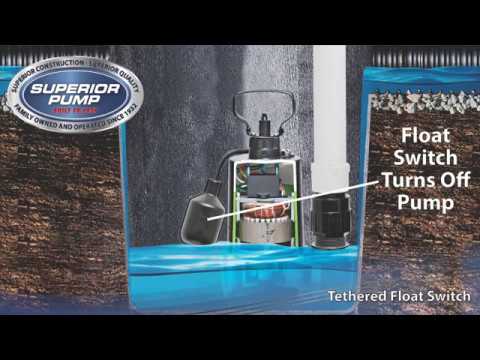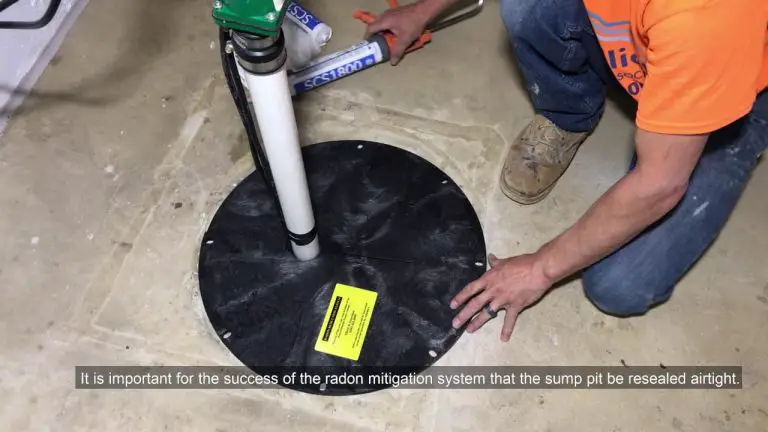How a Sump Pump Float Switch Works
A sump pump is a device that is used to remove water that has accumulated in a water-collecting basin, typically found in the basement of homes. The water is pumped out of the sump pit and away from the home.
A float switch is often used with a sump pump. The float switch turns the pump on when the water level rises to a certain point, and turns the pump off when the water level drops below that point.
A sump pump float switch is a device that is used to detect the water level in a sump pit. The float switch consists of a float, which is connected to a lever, and a switch.
When the water level rises, the float rises with it and activates the switch, which turns on the pump. Conversely, when the water level falls, the float falls with it and deactivates the switch, which turns off the pump.
How does a float switch work in a tank and submersible pump | Float Switch working animation
How Does a Float Switch Work on a Submersible Pump
If you have a submersible pump, it is likely that it has a float switch. This type of switch is used to turn the pump on and off based on the water level.
Here’s how it works: The float switch consists of a float (usually made of foam or plastic) that is connected to a lever. The lever is attached to a switch that controls the power to the pump.
When the water level rises, so does the float. This causes the lever to move, which in turn activates or deactivates the switch depending on the position of thefloat.
If you’re wondering why your submersible pump won’t turn on, check to see if the water level is high enough to trigger the float switch. If not, simply raise the float until it reaches the desired water level.
How to Adjust Sump Pump Float
If your sump pump float is not properly adjusted, it can cause your pump to run too often or not often enough. An improperly adjusted float can also cause your pump to shut off prematurely, leaving your basement at risk for flooding.
To adjust your sump pump float, first make sure that the power is turned off to the unit. Next, locate the adjustment knob on the side of the float housing.
This knob will usually be marked with an up and down arrow. Turn the knob in the direction of the arrow until the float reaches the proper level.
The proper level will vary depending on the model of sump pump you have, so consult your owner’s manual for specific instructions. Once you have reached the proper level, turn off the power to the unit and test it by pouring a bucket of water into the sump pit.
The float should rise and trigger the pump to turn on. If everything seems to be working properly, you’re all set!
Sump Pump Float Switch Types
Sump Pump Float Switch Types There are many different types of sump pump float switches on the market today. Choosing the right one for your needs can be a daunting task.
Here is a quick guide to the most common types of float switches to help you make an informed decision. Piggyback float switch: This type of float switch is mounted on top of the sump pump and typically used in smaller pits.
It is easy to install and wire, but can be less reliable than other types of float switches. If your pit is subject to large amounts of debris, this type of switch can become fouled easily and cause your pump to fail.
Tether float switch: A tether float switch consists of a buoyant ball connected to the pump by a cord or chain. As water level rise in the pit, the ball floats up, pulling on the cord which activates the switch.
Tether switches are more durable than piggyback switches and less likely to become fouled by debris, but can be more difficult to wire correctly. Be sure to follow all manufacturer instructions when installing this type of switch.
Sump Pump Diaphragm Switch Vs Float
A sump pump diaphragm switch is a device that is used to turn a sump pump on and off. It is usually mounted on the side of the sump pit.
The diaphragm switch consists of two metal plates that are connected by a rubber diaphragm. One metal plate is connected to the float, and the other metal plate is connected to the power source.
When the water level in the sump pit rises, it lifts the float, which in turn pushes up on the diaphragm. This action closes the circuit between the two metal plates, allowing electricity to flow to the sump pump.
The sump pump then turns on and begins pumping water out of the pit. When the water level drops back down, it lowers the float and releases pressure on the diaphragm.
This action opens up the circuit between the two metal plates, stopping electricity from flowing tothe sump pump. The sump pump then turns off.
A float switch works in a similar way as a diaphragm switch, but instead of using a rubber diaphragm, it uses a floating ball or other object that moves up and down with changes in water level. As with a diaphragm switch, when water levels rise high enough, it causesthe float to rise and close an electrical circuit that powers onthe sump pump.
Universal Sump Pump Float Switch
A sump pump float switch is a device that is used to automatically turn a sump pump on and off. The float switch is typically mounted inside the sump pit, and it consists of a float that rises and falls with the water level.
When the water level reaches a certain point, the float activates the switch, which then turns the pump on. The pump will run until the water level drops below the activation point, at which time the switch will turn the pump off.
The main advantage of using a float switch is that it prevents your sump pump from running unnecessarily – for example, if there is a heavy rainstorm and your basement floods, you don’t want your sump pump to be running constantly and draining your battery power. By using a float switch, you can be sure that your sump pump will only kick in when it’s needed.
There are two types of float switches: mechanical and electronic. Mechanical float switches are less expensive but they can get stuck in “on” or “off” position, which means that your sump pump may not operate properly when you need it.
Electronic float switches are more expensive but they offer greater reliability. If you’re considering purchasing a sump pump, be sure to ask about installing a float switch as well – it could end up saving you a lot of headache (and money) down the road!
Sump Pump Float Switch Replacement
If your sump pump float switch needs to be replaced, it’s a relatively easy job that you can do yourself. The first thing you need to do is identify the type of float switch you have.
There are two main types of float switches: mechanical and electronic. Most sump pumps have a mechanical float switch, but if yours has an electronic one, you’ll need to take it to a qualified technician for replacement.
Once you know what type of float switch you have, the next step is to turn off the power to your sump pump. You can do this by unplugging the unit from the outlet or by flipping the circuit breaker in your electrical panel.
With the power off, remove the old float switch and install the new one in its place. Be sure to follow any instructions that come with your new switch, and then turn the power back on and test it out by running some water into your sump pit. If you found this information helpful, be sure to check out our other blog posts for more home improvement tips!
Sump Pump Float Switch Not Working
If your sump pump float switch isn’t working, there are a few things you can do to try and fix the problem. First, check to see if the float itself is stuck.
Sometimes debris can get caught in the float and prevent it from moving up and down as it should. If this is the case, simply remove the debris and see if that solves the problem.
Another possibility is that the switch itself is faulty. This is usually a more serious issue that will require you to replace the switch.
However, before you do so, be sure to check all of the wiring to make sure everything is connected properly. Sometimes a loose wire can be the culprit behind a malfunctioning float switch.
Whatever the cause of your problem may be, getting your sump pump float switch working again is important to keep your basement from flooding. Be sure to take care of any issues as soon as possible to avoid any costly repairs down the road!

Credit: en.wikipedia.org
How Does a Float Pump Switch Work?
A float pump switch is a type of mechanical switch that uses a float to operate. The float is connected to the arm of the switch, and when the float rises or falls with the water level, it activates or deactivates the switch.
Float switches are used in many different applications, such as sump pumps, sewage pumps, and bilge pumps. They are also used in some HVAC systems to control condensate overflow shut-off valves. Float switches can be used with both submersible and non-submersible pumps.
How Does a Sump Pump Piggyback Float Switch Work?
Most sump pumps come with a float switch that is designed to automatically turn the pump on and off as needed. The float switch is typically mounted inside the sump pit, and it consists of a float that rises and falls with the water level.
When the water level reaches a certain point, the float triggers the switch to turn the pump on. Once the water is pumped out of the pit, the float drops back down and turns the pump off.
Some sump pumps also come with what is known as a piggyback float switch. This type of switch is designed to provide an extra layer of protection in case the primary float switch fails.
The piggyback switch is typically mounted above the primary float switch, and it too consists of a float that rises and falls with the water level. If the water level gets too high and triggers the primary float switch to turn on, then it will also trigger the piggyback switch to turn on. And if for some reason both switches were to fail, then there would be an alarm or another type of backup system in place to notify you that your basement was flooding.
How Do You Test a Sump Pump Float Switch?
A sump pump float switch is a device that turns the pump on and off as needed to keep the water level in the sump pit within a specified range. To test a float switch, first make sure that it is properly mounted in the sump pit and that the power is turned off to the pump.
Next, fill the pit with enough water to raise the float to its highest position, then turn on the power to see if the pump activates. If it does not, check for obstructions in the pit or any loose wiring connections.
How Do I Know If My Sump Pump Float is Stuck?
If your sump pump float is stuck, there are a few things you can do to try and fix the issue. First, you will want to make sure that there is no debris or dirt blocking the float from moving up and down.
If there is anything blocking it, you can try using a small brush or compressed air to clean it out. If that does not work, you may need to replace the float altogether.
Conclusion
A sump pump float switch is an important part of a sump pump system. It helps to automatically turn the pump on and off as needed, based on the water level in the sump pit. This can help to prevent flooding and water damage in your home.





